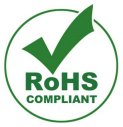 RoHS stands for Restriction of Hazardous Substances, and impacts the entire electronics industry and many electrical products as well. The original RoHS, also known as Directive 2002/95/EC, originated in the European Union in 2002 and restricts the use of six hazardous materials found in electrical and electronic products. All applicable products in the EU market since July 1, 2006 must pass RoHS compliance. It is a mandatory standard established by EU legislation.
RoHS stands for Restriction of Hazardous Substances, and impacts the entire electronics industry and many electrical products as well. The original RoHS, also known as Directive 2002/95/EC, originated in the European Union in 2002 and restricts the use of six hazardous materials found in electrical and electronic products. All applicable products in the EU market since July 1, 2006 must pass RoHS compliance. It is a mandatory standard established by EU legislation.
Directive 2011/65/EU was published in 2011 by the EU, which is known as RoHS-Recast or RoHS 2. RoHS 2 includes a CE-marking directive, with RoHS compliance now being required for CE marking of products. RoHS 2 also added Categories 8 and 9, and has additional compliance recordkeeping requirements.
Directive 2015/863 is known as RoHS 3. RoHS 3 adds four additional restricted substances (phthalates) to the list of six. RoHS 3 Deadline is 22 July 2019.
Are the LED lighting products manufactured by CIKI compliant with RoHS 3.0?
By the end of 2018, the standard of “AIPLY” brand LED lighting products produced by CIKI Company for export to the European Union is RoHS2.0. We will continue to follow RoHS’s official promotion of the RoHS3.0 standard.
And actively participate in testing in order to make the products produced by CIKI meet the latest standards and appear in the European market in the form of RoHS3.0. Bring better and safer products to customers.
Any business that sells applicable electrical or electronic products, equipment, sub-assemblies, cables, components, or spare parts directly to RoHS-directed countries, or sells to resellers, distributors or integrators that in turn sell products to these countries, is impacted if they utilize any of the restricted 10 substances.
With the rapid spread of digitization, the world’s production of electrical and electronic devices is exploding. Besides mobile devices, think about the coming wave of IoT, smart home assistants, robots, drones, 3D printers, and home medical devices to all corners of the planet….they are all regulated under RoHS.
EU RoHS specifies maximum levels for the following 10 restricted substances. The first six applied to the original RoHS while the last four were added under RoHS 3.0, which takes effect July 22, 2019.
- Cadmium (Cd): < 100 ppm
- Lead (Pb): < 1000 ppm
- Mercury (Hg): < 1000 ppm
- Hexavalent Chromium: (Cr VI) < 1000 ppm
- Polybrominated Biphenyls (PBB): < 1000 ppm
- Polybrominated Diphenyl Ethers (PBDE): < 1000 ppm
- Bis(2-Ethylhexyl) phthalate (DEHP): < 1000 ppm
- Benzyl butyl phthalate (BBP): < 1000 ppm
- Dibutyl phthalate (DBP): < 1000 ppm
- Diisobutyl phthalate (DIBP): < 1000 ppm
Related to RoHS is WEEE, which stands for Waste from Electrical and Electronic Equipment. WEEE Directive 2002/96/EC mandates the treatment, recovery and recycling of electric and electronic equipment (90% ends up in landfills). All applicable products in the EU market must pass WEEE compliance and carry the “”Wheelie Bin”” sticker.
Refer to the RoHS website for a description of this: https://rohsguide.com/rohs3.htm








